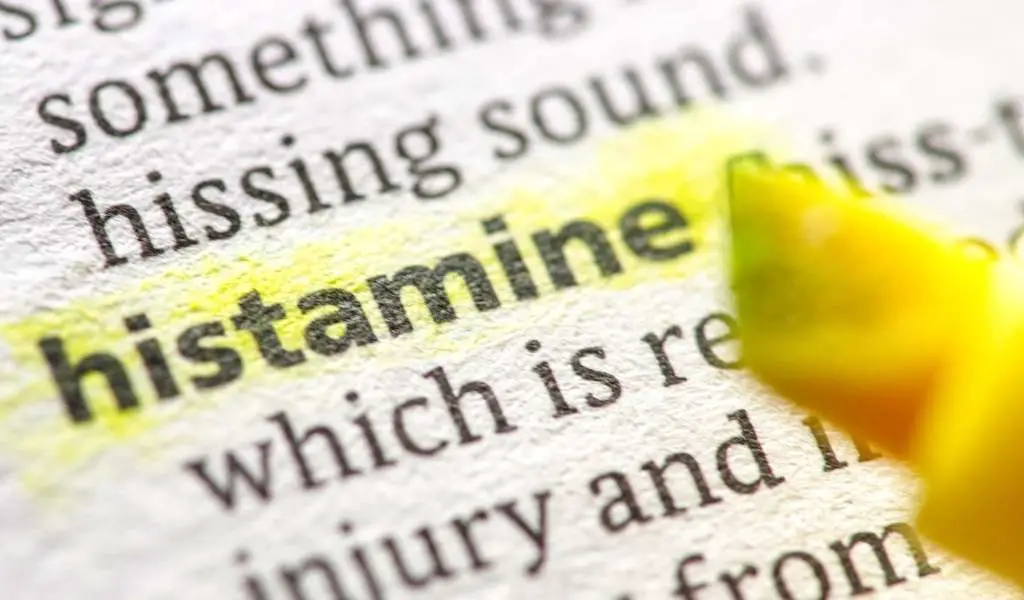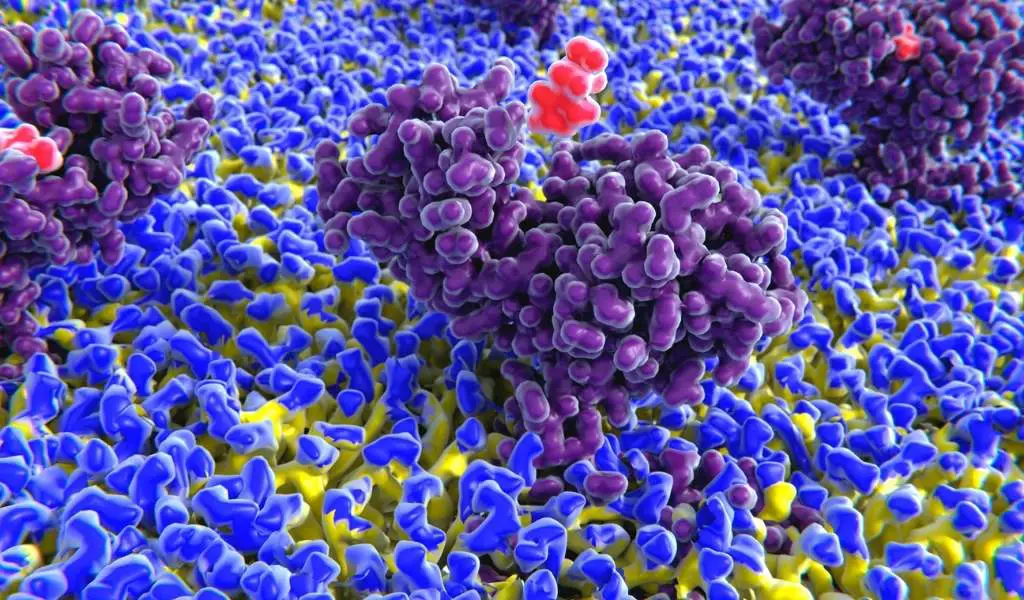Are there histamines in wine? It matters if you have histamine intolerance. Histamines are an intricate component of our body’s immune system, with a role extending beyond their commonly associated allergy response.
Our bodies produce histamine as a response to allergies and inflammation, but we can also ingest histamines through food and drinks.
Let’s explore histamines in relation to wine and their impact on histamine levels and intolerance symptoms. We’ll delve deeper into the world of histamines. You’ll discover their significance in the context of wine consumption and the potential effects they can have on your histamine level and the symptoms of histamine intolerance.

What Are Histamines?
Histamines are chemical compounds that help regulate various functions in your body. Mast cells, a type of immune cell, histamine producers, but you also find histamine in many tissues in your body. Beyond the role they play in allergic reactions, many tissues in your body contain histamine.
Here, they help regulate various chemical reactions that affect your mental and physical health. That’s why the symptoms of histamine intolerance can be so diverse.
Plus, you need histamine to make hydrochloric acid in your stomach to help digest your food. If you have seasonal allergies, you know that histamine causes many of the allergy symptoms you experience, such as sneezing and watery eyes.
High-Histamine Foods Can Worsen Histamine Intolerance
Histamines are not only derived from the foods and beverages you consume but various food sources contain histamines or trigger its release. High-histamine foods, such as processed meats, specific types of cheese, and fermented food items, serve as prime examples of these sources.
Most individuals can efficiently process and eliminate histamine from their body, allowing them to tolerate these high-histamine dietary items without issue. However, histamines pose challenges for individuals with histamine intolerance, a condition characterized by an excessive accumulation of histamine in the body.
Symptoms of histamine intolerance often mimic allergic responses, encompassing sneezing, hives, headaches, nausea, and digestive disturbances.
Histamines in Wine? Does Wine Trigger Histamine Release?
If you enjoy a cup of wine with dinner or at a social gathering and have histamine intolerance, you might question the histamines in wine. Are there enough to trigger histamine intolerance symptoms?
Since wine is a fermented food, it contains histamines due to the fermentation and aging process it undergoes.
Drinking wine triggers or worsens histamine intolerance symptoms in a portion of histamine sufferers but some question whether it’s the histamines in wine or the sulfites in wine that are responsible for triggering the symptoms. Some people are sensitive to the sulfites in wine and aren’t aware of it.
Sulfites can prompt histamine release in some cases. Plus, what do most people eat with wine? Usually, hard cheese, another food high in histamine. So, having a wine and cheese party wouldn’t be a smart move if you have histamine intolerance!
Intolerance to Red Wine: Is It the Histamines in Wine?
People who are intolerant to red wine experience symptoms like flushing, itching, headache, and diarrhea. In one study researchers conducted a red wine provocation test on 28 patients with wine intolerance and 10 controls who didn’t have histamine intolerance.
Of the subjects, 22 out of the 28 had elevated levels of histamine within 30 minutes. (1) This should make you feel cautious about drinking wine if you have histamine intolerance.
According to one study, wine intolerance reactions, often referred to as pseudo allergic reactions, are triggered by various ingredients in wine, including histamine, ethanol, acetaldehyde, acetic acid, and sulfites. (3) Plus, wine contains other biogenic amines that can cause sensitivity reactions.
Beyond histamine, some of the biogenic amines in wine include putrescine, cadaverine, spermine and spermidine. (4, 5) ) Scientists are exploring ways to remove biogenic amines from wine but there isn’t a reliable way to do that yet. (4)

Does Red Wine Have Histamines: Variations in Histamine Levels in Different Wines
Wines vary in the amount of histamine they contain. Does red wine have histamines? You’ll typically get more histamines when you sip a cup of red wine than white wine. Why might this be?
According to one study, red wine contains 60 to 3800 micrograms/liter in red wine. (1) So, the amount can vary widely.
Wine makers often ferment red wine with seeds and skins. The seeds and skins are rich in tannins—a potential irritant that contributes to increased histamine production. But be aware that histamines in wine vary widely based on the type of grape, its age, and how it’s fermented. (2)
Are there histamines in white wine? According to one analysis, white wine contains 3 to 120 micrograms/liter of histamines. (1) So, white wine contains significantly less than red wine.
Effects of Histamines in Wine on Histamine Intolerance Symptoms
So, what happens when you sip a histamine-containing beverage, like wine? Histamine attaches to specific histamine receptors, triggering a histamine reaction.(6)
In response, your blood vessels expand, smooth muscles in your airways contract, mucous secretion increases in your stomach, and you can even experience a drop in blood pressure.
A healthy person can break down histamines once they’ve served their purpose and don’t develop histamine intolerance, or allergic-like symptoms. With histamine intolerance, this isn’t the case and there’s heightened sensitivity to even minor histamine levels.
When this occurs, drinking wine can lead to symptoms akin to an allergic reaction, including diarrhea, difficulty breathing, hives, low blood pressure, nausea, blocked or runny nose, and flushed cheeks. (7)

Histamines in Other Alcoholic Beverages
Other alcoholic beverages may contain varying quantities of histamine too. Plus, alcohol has the potential to reduce activity of diamine oxidase (DAO), the enzyme that breaks down histamine. So, it’s a double whammy, being a source of histamine while reducing its breakdown.
Beer, in particular, contains histamine, with varying quantities ranging from 21 to 305 micrograms per liter. (1)
Are There Histamine-Free Wines?
Currently, there are no wines available that are entirely free of histamines. Histamine particles are so small that it makes them challenging to filter out entirely during the winemaking process, unlike larger sediments like sulfites.
If you don’t want to avoid wine entire, you can minimize your histamine intake may opt for dry white wines like Sauvignon Blanc or sparkling varieties such as Cava or Prosecco, which naturally contain lower levels of histamines compared to red wines.
Keep a Food Journal if You Drink Wine with Histamine Intolerance
The only way to know how your body responds to the histamines in wine is to keep a food and drink journal where you write down what you eat and drink and the symptoms that occur afterward. Keep a journal for at least 3 weeks, so you can identify specific triggers and patterns.
Include other important information such as the time you consumed a food or beverage, such as wine, and carefully document your symptoms. It may also be helpful to work with your healthcare provider and a dietitian to work out a low-histamine diet that will also be healthful and balanced.
Wine and Histamine Intolerance
From their vital role in immune responses to their presence in various food and beverage items, histamines continue to intrigue and sometimes challenge our bodies.
Understanding histamines, their potential effects, and keeping a food diary, so you know how your body responds to specific foods and beverages will help you make smarter dietary choices that won’t trigger histamine intolerance symptoms.
As you embark on your wine journey, armed with this knowledge, we encourage you to savor your favorite wines responsibly and without unnecessary concerns about histamines. Now, find out whether whiskey is high in histamine.
Key Takeaways
- Histamines are chemical compounds produced by mast cells and found in various tissues in the body.
- Histamines have diverse roles beyond allergies, including regulating chemical reactions that impact mental and physical health.
- Histamine is essential for producing stomach acid, aiding in food digestion.
- High-histamine foods like processed meats, certain cheeses, and fermented foods can worsen histamine intolerance symptoms.
- Wine, as a fermented product, contains histamines due to the fermentation and aging process.
- Some individuals with histamine intolerance may react to the sulfites in wine.
- Red wine often contains more histamines than white wine, with varying levels based on factors like grape type and fermentation.
- When histamine intolerance occurs, drinking wine can lead to allergic-like symptoms such as diarrhea, hives, and difficulty breathing.
- Other alcoholic beverages like beer may also contain varying quantities of histamine.
- Currently, there are no histamine-free wines available due to the difficulty of filtering out histamine particles during winemaking.
- Keeping a food and drink journal is essential to understanding how your body responds to histamines in wine and identifying specific triggers and patterns.
- Working with a healthcare provider and dietitian can help develop a low-histamine diet that is balanced and healthful.
References:
- Wantke F, Götz M, Jarisch R. The red wine provocation test: intolerance to histamine as a model for food intolerance. Allergy Proc. 1994 Jan-Feb;15(1):27-32. doi: 10.2500/108854194778816599. PMID: 8005453.
- N. Ageyeva, A. Shirshova, A. Tikhonova. Influence of Alcoholic and Malolactic Fermentation on the Level of Biogenic Amines in Wine. Food Processing: Techniques and Technology. Published 2021. Accessed September 25, 2023. https://www.semanticscholar.org/paper/Influence-of-Alcoholic-and-Malolactic-Fermentation-Ageyeva-Shirshova/e8d5ba2b3d144c5efe44fe2a82de1623cd728b56
- Wüthrich B. Allergic and intolerance reactions to wine. Allergol Select. 2018 Sep 1;2(1):80-88. doi: 10.5414/ALX01420E. PMID: 31826033; PMCID: PMC6883207.
- “Removal of biogenic amines from wines by chemisorption on functionalized silica and effects on other wine components”. Www.Nature.Com, 2023, https://www.nature.com/articles/s41598-020-74287-3. Accessed 25 Sep 2023.
- “Amghouz, Z.. Biogenic amines in wine: a review”. Ifst.Onlinelibrary.Wiley.Com, 2023, https://ifst.onlinelibrary.wiley.com/doi/abs/10.1111/ijfs.12833. Accessed 25 Sep 2023.
- Shulpekova YO, Nechaev VM, Popova IR, Deeva TA, Kopylov AT, Malsagova KA, Kaysheva AL, Ivashkin VT. Food Intolerance: The Role of Histamine. Nutrients. 2021 Sep 15;13(9):3207. doi: 10.3390/nu13093207. PMID: 34579083; PMCID: PMC8469513.
- “Allergic to Alcohol? 10 Common Symptoms of Alcohol Intolerance – GoodRx.” 14 Apr. 2023, https://www.goodrx.com/health-topic/alcohol/allergic-to-alcohol-intolerance-symptoms.

